#perhaps i am laser focused on the production design because...its me
Explore tagged Tumblr posts
Text
holding the hands of everyone in my notes rn.....the furniture in the dubai set has not changed a single time in these two seasons...those chairs have literally always been there
#they have two identical L shaped couches that bank one another and and a pair of chairs that surround a coffee table#the chairs and the couch dont even look the same theyre just all that same grey#perhaps i am laser focused on the production design because...its me#but also i just saw someone say louis hallucinate the chair ghostat sits in#like...idk do we need to talk about interior design? cohesive color pallets?? feng shui???#char.txt#interview with the vampire
5 notes
·
View notes
Text
Why are Konami’s MSX games fun? Interview from Beep #35 (1987/09)
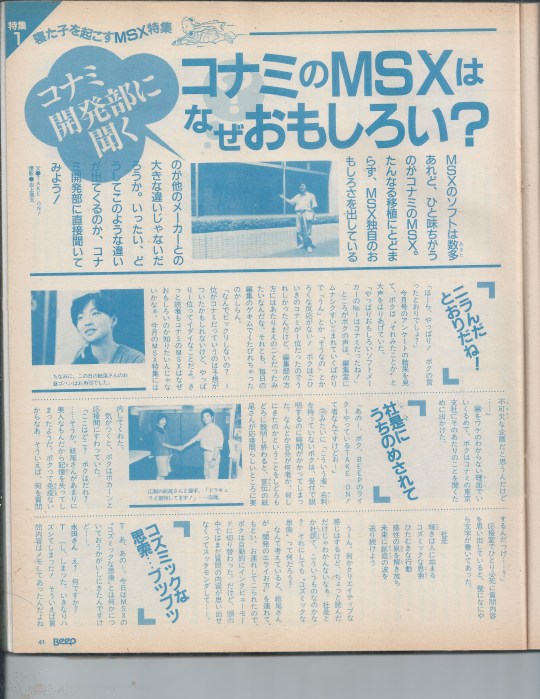
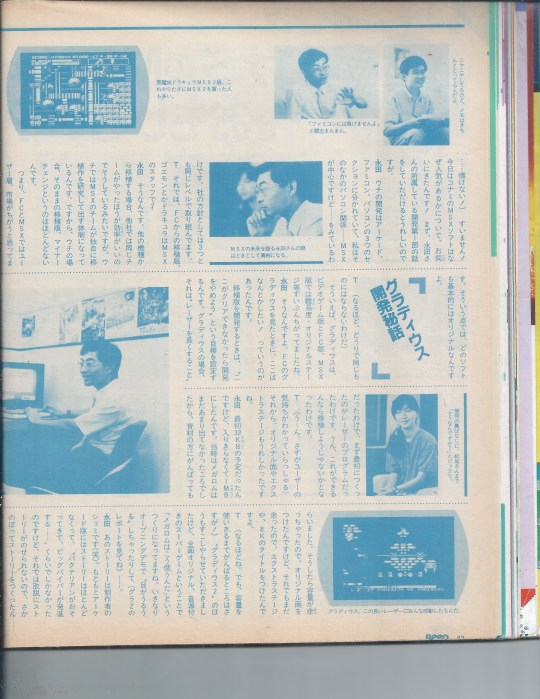
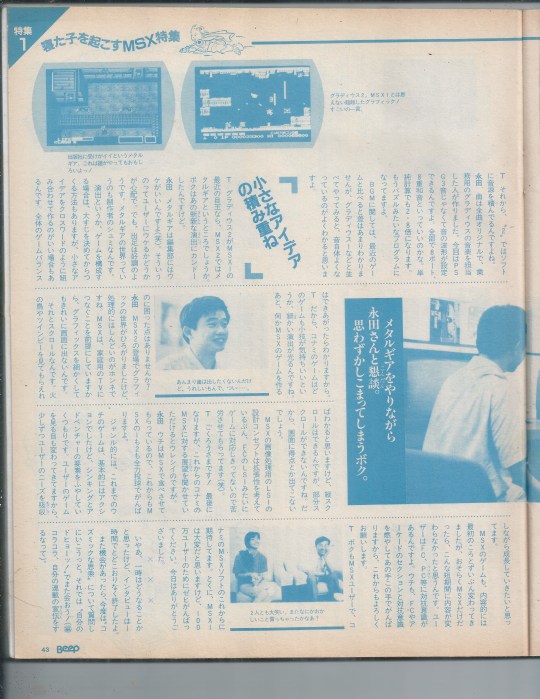
We Asked Konami’s Development Division
Text by TAKE ON!
Photographs by: Keita Iwagami
While there are many gaming software for the MSX, there’s something special about Konami’s MSX titles that makes them stand out. Rather than just doing simple ports from other platforms, their titles have a unique charm to them that titles from other developers might lack. To find out how they do it, we tried asking Konami directly.
Just as Expected
“Hey, I knew it! It’s just like I predicted.” As I saw the results of this issue’s survey, I raised my voiced and shouted “Did you see this? Konami was voted the number 1 software maker for the MSX!” However, my voice was simply absorbed by the editing room, with no even a simple “yes” or “I see”-type of response. While I was happy that my favorite company Konami took the no. 1 spot, the editors around me didn’t seem very impressed by that. Perhaps they were exhausted by all the hard work they were doing everyday.
“Why are you guys not impressed? Maybe Konami being No. 1 was too predictable, but it’s still outstanding. Perhaps our readers might want to find out why their games are so interesting. I think such an article will probably be invaluable for this issue’s special MSX coverage...” After trying to argue with the editors in a way that made no sense, I went to Konami’s branch office at Tokyo to interview them.
Overwhelmed by the Company’s Policy
“Uhh, my name is Take On, I’m a writer for Beep magazine.” Like a country bumpkin, I went there without a business card stating who I was, so I had to spent time explaining myself away to the receptionist. After somehow managing to explain who I was and why I came there, Ms. [Akemi] Kamio, Konami’s spokeswoman, led me to what seems to be the reception room.
Before I knew it, I was sitting absent-mindedly at the reception room. “Where am I? Who am I? Ah! Ms. Kamio is such a beauty, that I almost lost my memory. I’m not so used to that. By the way, what was I going to talk about...”
While desperately trying to remember what kind of questions I had in mind, I noticed there was some kind of writing on the wall.
Company’s Policy:
Brilliance Begins With People
Cosmic Pondering
Earnest Action
Release the Fountain of Sensitivity
And Continue Sending Waves of Creativity
Into The Future
Huh. It has a very creative feeling to it, but I have no idea what it means by just reading it. What sort of company policy or philosophy was this? And what the heck was a “cosmic pondering”?
While I was thinking about this, Ms. Kamio guided me, or rather lured me to the “great developer”, so I automatically switched to interview mode. But I still didn’t know what was going to be my first question, so I ended up fumbling a bit.
Cosmic Pondering
Take On!: Uh-hello! I came here today to ask about the MSX and its “cosmic pondering”?
Akihiko Nagata: Uh, pardon me!?
T: (Crap! I fumbled my way so suddenly. Come to think of it, I did brought a notepad with me with the questions I had in mind. How silly of me.) Sorry about that! What I meant to say was that I came here to ask about why Konami’s MSX games are so popular. I would be glad if you could start by talking about Konami’s development department no. 1, the group you belong to.
Nagata: Our company’s development team is divided by three sections: Arcade, Famicom and PC. As you see, my department focuses on PC gaming development, even though most of our games are for the MSX. The company’s plan of action is to have the three sections assembled to work on the same level.
T: Does that mean that titles such as Ganbare Goemon and Akumajo Dracula [Vampire Killer], which were ported from Famicom games, have their own staffs for the MSX versions?
Nagata: That’s right. When it comes to porting a game from one platform to another, other companies tend to have the same team involved with the port. We could do that too, since it’s very efficient, but our company has a structure which allows the MSX team to independently research and develop its own ports. As a result, we hardly release any port that is just the same game with a few minor changes. In other words, because we feel the class of users for the Famicom and MSX, as well as the market, are different, we’re doing a full-time service for each, In that sense, each software is basically its own original product.
The Inside Story of the Gradius Development
T: (I see. With such a logic, you won’t have an identical product.) Speaking of which, the MSX version of Gradius [Nemesis] was very different compared to the arcade and Famicom versions when it came to aspects like the difficulty level and the additional stages.
Nagata: That’s right. When I saw the development of the Famicom version of Gradius I felt a sense of “I really want to do this”. When it comes to developing a port, we set milestones with the condition that “if we can’t complete this, then we must cancel the development.” In the case of Gradius, making the laser long was such a condition, so the first thing we ended up doing was the programming for the laser itself. If we could accomplish that, then we can surely port the game.
T: (He really knows how players feel.) That’s why I was glad when it had new area and the hidden extra stages.
Nagata: Originally we were set to develop the game on a 32 kilobyte cartridge, but that was not sufficient to fit everything we wanted, so it was increased to 1-Megabit. Because there weren’t that many Megarom cartridges back then, we worked hard to make the best of it. We ended up with excess space, so we added a new regular stage to make use of it, but that was still not enough content to fill the extra space, so we added the hidden extra stages, as well as title screen that took 8-kilobyte.
T: (I see. But still, doing your best to make full use of the game’s given memory is pretty amazing.) I had the chance to play Gradius 2 [Nemesis 2] a while ago. It’s a superb game with all new stages and inclusion of a sound source that seems like it was developed specifically for the Megarom cartridge format. Particularly with its opening story sequence that made me teary-eyed.
Nagata: That story was something that its lead designer was particularly fixated with. (laughs) The original arcade version of Gradius didn’t have much of a story other than “the Bacterions are coming, deploy the Vic Viper”, but that wasn’t enough for the manual, so we had to go back and write a new story.
T: And then Gradius 2 added a sound source to the software.
Nagata: The music is all new and composed by the same person who did the music for the original arcade version of Gradius. This time we were able to employ audio waveforms in addition to the standard 3 PSG channels. All in all, you could say it has 8 ports or 8 chords. Simple calculations are also increased by 2.8 times. The programming is already like a puzzle. As for the music itself, you might not be able to tell the difference when compared to a recent game, but when compared to the first Gradius, you’ll see that the sound itself was considerably improved.
A Gathering of Little Ideas
T: Lately Gradius 2 has served as the centerpiece of the MSX1, but where does that leave Metal Gear in regards to the MSX2? I was very impressed by the innovative direction it took.
Nagata: I’m glad that the game was well-received by your staff. (laughs) I was concerned whether or not the game would be well-received by players or not. But it seems like we’re off to a good start. The world of Metal Gear was also something that its designer was particularly fixated with. When it comes to directing, or rather structuring a game, there are ways to create it after deciding on its main ideas, but sometimes it’s better to mix up a lot of little ideas like a crossword. You’ll know the game’s overall balance when it’s finished.
T: That’s why all Konami games have subtle little touches or shine with their presentation. Are there any particular problems when it comes to developing an MSX game?
Nagata: Sincerely, while the world of graphics have expanded since the introduction of the MSX2, it is very difficult in terms of processing. The MSX was designed to be used on a home television set [as opposed to a computer monitor], so even if you make the graphics more detailed, it still won’t look very pretty on a TV screen.
And then there’s the scrolling. If you’ve seen TwinBee or Hinotori, you’ll understand. The machine is capable of vertical-scrolling, but not horizontal. That’s why you won’t see anything like points on-screen.
The LSI concept for the MSX’s image processing was designed with scalability in mind, but it wasn’t compatible with the kind of LSI employed by the Famicom, so that gave us a lot of problem.
T: You done a great job! Finally, I would be glad if you could tell us what’s Konami’s outlook for the future of the MSX.
Nagata: We’ve been allowed to make a living off the MSX, so we’ll continue to do our best when it comes to both, the MSX1 and MSX2.
When it comes to genre, our company has been basically making only action games up to this point, but we plan on adding more cerebral and adventure elements to future titles. The way users are viewing games are changing, so we want to grow while gradually attracting their needs.
Our MSX games have changed a lot content-wise since we started making them, but I don’t think they would changed that much in such a short time if we were doing only MSX games. There’s a sense of rivalry among Famicom and other PC users. We’re also going to do our best to compete with the arcade and Famicom sections anyway we can, so please continue to support us.
T: As an MSX user myself, I’m looking forward to Konami’s future games for the platform. I know it’s a lot of work, especially when it comes to the MSX1, but for the one million users out there please keep up the good work. Thank you for your time.
I was worried about what was going to happen at one point, but the interviewed ended in a hour without a hitch. If I get the opportunity, next time I’ll ask about what exactly a “cosmic pondering” is. Until then, see you again in “my own forum!” (Editor’s note: “Hey! Don’t advertise your own serial!”
Source
Beep Vol. 3 No. 9 - September 1987 issue (Softbank Publishing)
14 notes
·
View notes
Text
Reordberend
(part 21 of ?; first; previous; next)
(BTW, as of this update, Reordberend is, by my count, a little over 45k words long, putting it in the territory of a shortish novel. That also makes it one of the longest SF stories I’ve ever written. It’s not the most popular thing I’ve ever posted on Tumblr, but it has gotten a steady trickle of notes. Knowing there are people out there who enjoy your work, even if it’s fairly niche, is the best motivation there is to keep writing. Thank you for reading!)
Katherine Alice Green The Guest Room in the Village Hall The High Settlement McMurdo Dry Valleys ANTARCTICA
to Dr. Eunice Valerie Gordon Trinity College Dublin Dublin 2 IRELAND
Dear Dr. Gordon,
I am writing yet another letter I won’t be able to send, which, I realize might make me seem like kind of a crazy person. The only defense I can plead, I guess, is that the perpetual darkness of the winters here does funny things to you if you’re not used to it, and I’ve had a lot of down time lately that I need to do something productive with. I have already written to my parents, to a couple of friends, and to my cat, which leaves only you. And these letters seem to have a way of focusing my thoughts, so maybe it’s not an entirely useless exercise.
Where to begin? Well, first of all, I’m alive. That may come as a surprise. It occured to me not long after I was marooned here that perhaps nobody knows that. No one has come looking for me, and why would they? If any rescue parties did go looking for the Albatross, I doubt they’d come this far south. Not in winter. But I did in fact survive the ship going down. I don’t think anybody else did. The Dry Valleys People didn’t find anyone else on the shore, alive or dead. I try not to think about that too much, but, to be honest, it still has me kind of fucked up.
Oh, that’s the other things. I’ve made contact with the Dry Valleys People. I am, as the return address indicates, currently living with them. They have welcomed me, rather reluctantly, and I’ll be able to remain at least until the first sunrise of spring. This was not necessarily a widely popular decision, and I’ve come to learn that the political situation among the DVP is rather complicated. They have always guarded their isolation and their independence, and they’re keen to keep guarding it in the future, but there are some among them who worry how long that will really be possible. I think this is something Dr. Wright foresaw, and tried to warn them about in the letter he sent with me. But as you might expect, this is something a large part of their community doesn’t want to hear or even think about, and my presence here is definitely fraught.
As for my original mission… well, it’s an unqualified success, despite the difficulties. I’ve learned a lot. The language, to start with. You won’t believe this, but they speak Old English here. No, not thee and thou and maketh yon Old English. Not Chaucer, even. Older. From their books and what they’ve told me, their ancestors used the West Saxon dialect of Old English, as spoken about the year 1000 AD, as the basis for the language they taught their children. Dr. Wright knew this, of course. That’s how he was able to communicate them and win their trust; he showed an affinity for the same history and the same long-term perspective they cared about. If it seems weird that a bunch of people would move to Antarctica, forsake almost every modern convenience, and deliberately teach their kids a dead language that would be useless in the wider world, well, all I can say I guess is that humans have done a lot of weird shit for a lot of weird reasons throughout history. I think I am beginning to understand why the ancestors of the DVP did what they did. Some of them have tried to explain it to me, but there is a gap in our worldviews here that is difficult to bridge.
One of the DVP that I have befriended is a poet named Leofric. His sister, Leofe, taught me the language, but I’ve learned a lot more about their literature from him. It’s primarily an oral literature, although they do write some of it down. They like long, semi-narrative poetry that draws heavily on the imagery of the natural world, and I would say that it owes something to the ancient Anglo-Saxon poetry they keep in their books, except that, of course, the environment here is nothing like the environment of England one thousand years ago. But there are still some poetic traditions they have inherited from those earlier examples. For instance, their world is harsh, and unforgiving, and from a certain angle looks like a world in decline. The ancient English (so I am told) were surrounded by great Roman ruins they spoke of as being the work of metaphorical giants; here, they have the ruins of two hundred years of scientific and industrial exploration of the Antarctic coast. And their world, too, is enclosed by a vast cold sea, although this one has penguins in it at least.
Aside from the language, the founders of the DVP don’t seem to have intended to recreate medieval English society. There are no kings. There is a semi-formal system of village headship by seniority, but the social hierarchy is very flat. Marriage, inheritance, and choice of occupation all take place on fairly egalitarian terms, and their strictest taboos surround the sharing of labor and resources, not sexuality or religion. I wonder how much of their customs are the result of gradual cultural evolution, or some deliberate effort at creating a planned community. There are lots of funny Utopian experimental communities out there, but most tend to fail after a generation. In a way, this one couldn’t fail, because they had no way to leave Antarctica. They had to make it work. Is this what a real utopian project looks like after six or seven generations?
But honestly, one of the most fascinating aspects of the DVP is their material culture. As you might expect, their day-to-day existence is profoundly shaped by the environment they live in. Their houses are all heavy stone, designed to trap scarce heat, and arranged around the village halls as a windbreak against the dry katabatic gales that sweep the McMurdo Valleys clear of ice. Despite this being one of the driest locations on Earth, it’s still a better habitat for them than the glaciers of the Antarctic lowlands, or the rough, icy terrain of the mountains--here, you can actually build, and you don’t need skis and snowshoes to get around. But, as a consequence, much of their most important infrastructure is underground.
I don’t know if the ancestral DVP brought the right tools with them or if they scavenged them once here, but they have accumulated a small stockpile of laser borers, ultrasonic chisels, and crystalsteel digging equipment that they use to carve out underground chambers in the hills as meeting places and ritual sites. But they don’t do their agriculture there; that happens in networks of buried trenches just below the villages, where they grow cold-resistant mosses and lichens to supplement a meat-based diet, and what seems to be a form of genegineered fibergrass they use to weave their clothing and tapestries, and to make books.
Their art is very beautiful. Their coats, books, and tapestries--even their stone carvings--all depict elaborate lineate forms of plants and animals, inherited I suppose from ancestral memory, since none of the organisms in question are found in Antarctica. They also make images depicting the mountains, of course, and the sea, and the animals that live on the coast; even some of the coastal settlements, as seen from far off. They’re often abstracted, but these images are geographically grounded: they’re not just “generic mountains” or “generic coastline,” they’re specific mountains, specific coastlines, and they add up--if you are exposed to them every day of your life growing up--to something like a conceptual map of all of Victoria Land. It seems that if you dropped an average adult DVP individual anywhere from Oates Land to the Queen Elizabeth Range, they could probably find their way home, even during the dark months of winter.
(Oh! And the dark months! You’d think they’d be depressing, but I never imagined in my life I would see such a sight as the aurora australis, or even the clear polar stars! I can’t describe it to you. Maybe Leofric could, if I could do justice to his verse.)
They’re very communitarian, and great emphasis is placed on making sure no one goes without, but the price of that is, apparently, extremely elaborate dispute-resolution mechanisms; for a culture without courts, government, or attorneys, they are remarkably bureaucratic. Each physical object seems to have its own laws attached to it. Some may be shared by all objects of that type--for instance, if you need an electric firestarter, you always go to the house windward of yours to ask if they have one. If they don’t, you go to the next, and so on; firestarters pass from house to house, as needed, but only in one direction. Other objects may have completely unique rules. There is a knife with an elaborately carved handle meant to be used only by left-handed people. I don’t know why; nobody I asked knew, either. But that was the custom, and it was scrupulously obeyed. As a rule, the more elaborately decorated an object, the more particular the rules associated with it, but the elaboration of the object doesn’t seem to connote anything about the rules. It only marks it out as somehow special. The rules themselves are transmitted orally. All of these rules at bottom are about making sure that resources are evenly distributed--making sure nobody has to walk too far in bitterly cold weather to find a firestarter, for instance--and even the ones that don’t make sense now probably were created for good reason. For instance, the southpaw knife. Their knives for carving meat all have handles that curve in one way, to help separate flesh from bone, and I suspect that one is the result of a left-handed steelsmith getting fed up with with tools he couldn’t use very well. The blade is that of a carving-knife, though the handle attached to it is straight. The handle was probably later replaced when it broke, and somebody needed the knife for a different purpose--but the custom attached to it remained the same.
This system of sharing is, if anything, even more scrupulously observed when there’s a windfall. We went on a salvage expedition a month ago and brought back some much-needed supplies, and they spent days working out what would go where, first to each village and then, once we got back to the High Settlement, each house in each village--and even then, this was just what went to who first. Anything that’s not a finite supply, like food, will get passed from house to house. Leofric tells me that a few years ago, a whale--an entire blue whale, actually--beached itself to the north, and they had to have a weeklong assembly (on the beach, next to the whale, natch) to decide what do with every scrap of meat and bone. They still talk about the arguments that went down at the Whale Parliament sometimes (for which their word is hwaelthing, by the way. Literally it means exactly what it looks like: “whale-thing.”). Funny thing is, they also very carefully manage arguments in these discussions. That’s not normally the case--if two people have an argument and what to physically fight each other about it, that’s considered their business. But when it comes to disputes about food or metal or tools, everybody is very keen to show how Not Mad they are, even if they’re actually seething about it on the inside. And if voices get raised, people get hustled aside, and the whole matter is dropped completely until everybody has a chance to calm down. This looks like a system that was either deliberately designed to keep fights from breaking out and feelings getting permanently hurt, or one that sprung up after some nasty experiences of actual fights. I suspect the latter. It’s all very informal, but there’s a lot of social pressure that enforces it. The price for division and discord in an environment this hard to live in would be death, and I think all their social institutions are built around that reality.
I will admit, this has not been the easiest experience. I mean, there’s the almost dying part, and the part where all my cybernetics are broken, and I had a bad bout of something flulike a few weeks ago and almost died again, but I don’t actually mean the physical hardship. It is a more isolating experience than I thought it would be, being the lone outsider in such a close-knit community. Everyone knows everybody and everything, except me. They all have their own jokes and stories and long-running feuds, and they can communicate a great deal to one another with just a glance, and I’m left wondering what just happened when everybody laughs at something, or a fight breaks out. I have struggled sometimes to learn the language. I mean, I’ve had no other choice, and it’s amazing what you can learn when your survival depends on it, but even now I still sometimes find myself struggling to communicate ideas, or staying silent even when there is something I might want to say, just because I can’t find the words. It’s infuriating not being able to express yourself well, and maybe for good reason I sometimes think they all see me as this hapless idiot who almost got herself killed, who they have to put up with until the spring as a result.
Okay, I mean, I kind of am that. But I am also genuinely interested in their society, in the DVP as individuals, in their stories and their history. But I feel like the best I can hope for is being kind of a mascot. Or a well-meaning but dim-witted pet. A Labrador or something.
Not that I haven’t made friends. I would say Leofric is a friend. The salvagers--Eadwig and Andrac--they’re friends. And I seem to have won at least the grudging toleration of the ones like Aelfric who initially wanted to leave me to die. But sometimes I think I’ve made a connection, somehow bridged the unbridgeable gulf between my life experience and the world of the DVP, only to find out I’ve done no such thing. I thought Leofe was a friend; but now she’s not speaking to me, and she’s left the High Settlement for one of the other valleys. I don’t know why, and the others just shrug when I ask them.
Ugh. This is turning into whining. Now I know I’ll never send it. Sorry. It’s been a long day. It’s amazing how tired you can get when your muscles can’t rely on your augs to help them do shit.
But I need to find a way to bridge that gap. I mean really bridge it. Because I feel like I’m starting to understand something the DVP aren’t ready to hear. Their ancestors came to Antarctica at a time when the rest of the world wasn’t much interested in it. It was a wasteland, so sure, let’s treat it as an international, shared territory. Nobody goes there but scientists and the occasional tourist. And during the Collapse, not even that--Antarctica was truly empty for the first time in a hundred and fifty years when the ancestors of the DVP came to its shores. But it isn’t anymore. And it won’t ever be a real wasteland again. Every year the mining consortia move a little further down the Transantarctic Mountains. Every year a new outpost pops up on the coast, more ships come to Port Alexander, more icebreakers cut through the polar sea. Antarctica is warmer now that it’s been at any time in the past. Heck, without some global warming, I don’t think the Dry Valleys would be habitable. But that means more exposed rock, more open ground to build on, more people coming to the continent to work on the mining platforms or the offshore factories, and one day, I think, they’re going to come here.
What will the DVP do when that happens? This isn’t North Sentinel Island, which nobody ever goes to because there’s no reason. There’s gold in the hills here--the DVP make jewelry out of it--and maybe other precious metals, and you could build a geothermal station on Mount Erebus and power a small town, if you wanted to build some autofactories. The Antarctic Authority exists to promote “science and industry,” but with a big emphasis on industry. And by science they mostly mean, like, watching penguins bone and building telescopes at the South Pole. Not soft stuff like anthropology. And certainly not protecting three valleys full of cessionist oddballs whose parents had an unreasonable fondness for dead languages.
I think Dr. Wright knew this. I think maybe he tried to warn the DVP when he was here, but back then the danger was even further away. And it’s hard to get people to pay attention to danger that seems far away, even if it might be an existential threat. And when dealing with that danger would require you to completely change the only life you’d ever known… well, that’s a hard sell. The DVP don’t really like change. I can’t blame them. But one day things are going to change here, and if they’re not prepared for it, it could get really ugly, really fast. It’s one thing to shut yourself away when the world is ignoring you. It’s another when the world comes knocking.
If I think I can persuade them, I’m going to talk to the elders here, Aelfric and Wulf. Some of the DVP have had very fleeting contact with outsiders before me. I think one of them should come with me in the spring, as a sort of emissary. I’m not sure who they should talk to, yet. Maybe the Authority. Maybe somebody in Port Alexander’s local government? Or maybe we should just try to tell their story directly to the world. That might bring the DVP more attention than they’d like, but better a little good attention now than a lot of bad attention later. I would have asked Leofe--she’s smart, she’s tough, she could handle the culture shock--but that’s not an option now. Something to think about, anyway.
Well. I hope this letter finds the imaginary version of you well, my love to the imaginary family &c, hope the undergrads aren’t giving you too much trouble this year. If for some reason you do find this letter--like I freeze to death on my way to the weather station in September and they find this document on my corpse--please forgive my stubbornness, my insistence on going on this stupid trip, and any worry I’ve caused you as a result. And if I really am dead, please tell everybody I died doing something badass, like, I dunno, fighting a polar bear. I guess those are extinct and they never lived in Antarctica anyway, but something along those lines. Make it good.
All the best,
Kate
#tanadrin's fiction#*blows party horn*#sorry for the epistolary chapter#but it's a great way to do gratuitous expository worldbuilding
11 notes
·
View notes
Text
LOT/CC fic: Somewhere on Your Road Tonight
Sara and Leonard made a life for themselves, together in 1958, after the Waverider left them, Ray and Kendra behind. But now they're back on the ship, Mick has been twisted into Chronos, Kendra is pregnant, and Savage is still out there. They'll deal--together. (Sequel to "Chances Are.")
Third of the "Destiny" chapters. Thanks to LarielRomeniel for the beta!
Can also be read here at AO3 or here at FF.net.
The Pilgrim’s ship is named the Scimitar. Leonard stands on its bridge and watches the Waverider depart with Sara, Rip and Stein. The medbay is keeping the professor stable, and as he’d mentioned with arch gallows humor, if nothing else, maybe he could arrange to blow up in Savage’s face.
Raymond stands with him and watches the ship, even as Mick, muttering to himself, punches buttons on the Scimitar and barks at them both to hold on—the smaller ship doesn’t have jump seats for passengers. Leonard’s pretty sure the scientist would have liked to go with the others to help save Kendra, but Raymond has also insisted that he needs more time to look at the diagrams they’ve put together for the Oculus device (through his and Stein’s know-how and Rip’s memories)—and time to instruct someone in how to deactivate what he calls the “core-contained supernova” that powers it.
So, he’s with them, but under strict orders not to put himself into any position that leads to him being disintegrated by an explosion or laser blast. Leonard would think that’d be rather a good thing to avoid, but the scientist is a bit annoyed about it, for some reason.
“You think I don’t have some sense of self-preservation?” he asks Mick and Leonard sulkily.
“No,” they’d responded in unison. Raymond had refused to talk to them for a good…well, 10 minutes, anyway.
Now, though, he’s apparently thoroughly forgiven them. “You OK?” he says with concern, turning to Leonard. “I mean, you must have wanted to go with Sara. I…”
Leonard really doesn’t want to do this right now. Or ever. “Fine, Raymond,” he not-quite-snaps. “I’m fine.”
“OK…” Raymond looks disappointed, then, glancing away. “I mean, I wish I could go with them too. Kendra…” He swallows. “I’m just worried about her.”
It hadn’t occurred to Leonard that the scientist’s concern for him might have been an attempt to distract himself from his own fear and worry. He hesitates, then sighs.
“She’s tough, Raymond,” he says quietly, as Mick snaps at them again and they move out of the way of the viewscreen. “And she’s going to fight. She’s not going to make anything easy for Savage.”
Raymond’s face contorts. “I know. Hell, she’s a lot tougher than I am.”
Leonard, who hadn’t been planning to say it himself, snorted. “Yeah.”
“But that doesn’t mean I don’t want to be there. I mean, don’t you?”
Aaannd, back to that again. Leonard rolls his eyes to cover his own unease. Just because he has feelings and has admitted that on occasion doesn’t mean he wants to talk about it. But it seems… perhaps he needs to remember, again, that he’s not alone here.
“I do,” he acknowledges with a sigh. “But I trust Sara. And she needs to be there. She’s the best at hand-to-hand, and they’re going to a very rough spot.”
Raymond nods. “I know.” He glances away. “I know. I just…eh, you get it.” He claps Leonard on the back and appears not to notice when the other man glares at him, turning away to look at Mick. “Um. How long?”
“Not long, Haircut.” Mick’s expression is focused and serious and not at all the Mick that Leonard’s been so familiar with over the years. “Now shut up and let me drive.”
“Shutting up.” Raymond makes a production of closing his mouth, then turns to Leonard. “OK, let’s go over this stuff again.” He crosses to a nearby screen and taps at it, studying the pictures that appear. “You, or Mick, will have to open the panel and reverse the polarity matrix.” He hesitates. “Probably you. Uh. You have the experience working with this sort of thing, and…” He clears his throat. “The hands.”
Leonard gives him a wry look. In a different time, this would be a remarkably entertaining opportunity to fluster the hell out of the other man. “Hands, Raymond?”
“Uh. Hands.” Raymond waves one of his own. “You know. Sensitive hands. You said it yourself…uh, I’m going to shut up now.”
“Good idea.” Leonard, smirking, briefly mourns the lost opportunity. He could get a lot of mileage out of this. The fingers of his right hand twitch again and he frowns, but chooses not to mention it. It’s been getting better. Gradually. “So. Tell me how I do this.”
“OK. From what we can tell…”
The thing is, Raymond’s right. Between Leonard’s experience with rewiring security systems since childhood and—innuendo aside—fairly dexterous hands (his new fingers twitch again; he ignores them again), he’s the right person for this job. That doesn’t stop the growing sense of doom that’s rising inexorably again, though, as it has since they’d decided who was going where, back on the Waverider bridge.
He has the oddest feeling he won’t be getting back on the ship. This one or the Waverider. He’d nearly told Sara that, but he’d lost his nerve. And now it’s too late. To say that, or anything.
Fuck, he hopes he’s wrong.
Leonard lets Raymond show him schematics and tell him earnestly about different scenarios for the Oculus system. While he’s increasingly sure, intellectually, that he can do this, his nerves are telling him otherwise.
Finally, he butts in when the scientist threatens to go off on another technical tangent. “What if there’s a fail-safe?”
Raymond blinks at him. “I…what? Why?”
“Common security feature.” Leonard rolls his eyes. “C’mon, Raymond. You really think they’d just leave this thing sitting there without something to protect it?” He leans forward, studying the diagram. “Remember, I haven’t only been deactivating security systems for years, I created a lot of them, back in 1958. So, the question is, what kind of fail-safe?”
Raymond looks perplexed, for some strange reason, but at least he listens. “What kinds are there?”
“Well, in the case of failure—or sabotage—does it shut off? Or does it somehow protect itself in another way? Is there redundancy?” Leonard frowns, tilting his head, looking at the plans. “Is the motive for it to be safe for people or the building if something goes wrong? Or for it to never fully stop working?”
“Well, reversing the polarity matrix will cause a really big boom—big enough to destroy the whole Vanishing Point, so it seems like they’d want to avoid that.” Raymond frowns. “Why didn’t I think of this?”
“Someone pulling your strings?” Leonard gives him a thin smile. “Or maybe it’s just because you’re not used to thinking like a crook.”
The other man doesn’t take the bait. “If I was designing this…”
Leonard considers thumping his head against the table—or thumping Raymond’s. “Damn it, Boy Scout, that’s what I just said. You didn’t. And the Time Bastards are far more mercenary and just plain mean. If someone tries to shut this down or blow it up…what would happen? Think like a Time Bastard.”
“I don’t think I can do that. But…”
But then Mick’s rumbling voice cuts in, making them both look up and around.
“Neither one of you are looking at it quite right,” the former bounty hunter informs them. Mick’s sitting back in the captain’s chair and regarding them, a mix of amusement and something darker in his gaze.
“Ultimately, they wouldn’t want it to fall into any hands but their own,” he comments. “Because if there’s one thing I know about the Time Masters, it’s that they think they always, always…” He looks at Leonard, who finishes the statement, remembering an earlier conversation.
“…know best. For everyone,” he says thoughtfully. “So…dead man’s switch?”
Raymond shakes his head. “The kind of device that activates if the operator lets go? That doesn’t seem…”
“More than one kind of dead man’s switch, Haircut.”
“Right.” Leonard starts to pace. “One can also shut down if the operator lets go. But how would that work? It…”
“Outta time, boss. We’re here.”
Leonard spins, staring out the window as the looming Vanishing Point, more sure than ever that something’s about to go horribly wrong. But as Mick says…they’re out of time.
He takes a deep breath, putting a hand on the cold gun, as Mick starts bringing the ship in for a landing, knowing how fast things will have to move when they touch down. Like at the cell block before, he’ll be out and moving for the wellspring chamber as the others take the ship up again and fire on any attackers, hopefully distracting them, providing an opportunity for a single person to get in and do the job.
But Raymond, ever optimistic, ever thinking, perks up then.
“You can use the Atom suit,” he says, reaching into his pocket and pulling out the capsule with the shrunken costume. “Why didn’t I think of that before?”
Leonard stares at him. “No.”
“Yes!” The scientist looks obdurate. “C’mon, Snart, it’s the least I can do if you’re going to insist I sit back and watch this.” He pauses as Leonard shakes his head. “If you won’t do it for me, do it for Sara. So she doesn’t have to kick my ass, or Mick’s, for letting you be killed.”
“He’s right,” Mick informs him. “Don’t be an idiot.”
Leonard glares but he’s outnumbered, and a part of him knows that they’re right.
“OK,” he says with a sigh, watching as Raymond restores the suit to full size. “Hurry up. Cliff’s Notes version. And there better be no photos.”
Mick laughs evilly. “Well, there weren’t going to be until you gave us the idea.”
Leonard sighs again.
Concurrent with the departure of the Scimitar
Rip has countless diagrams and maps and timelines that deal with when and how and where his family died. Sara, standing at the table in the study and staring at them, feels her heart go out to him again.
How many times has he tried? How many tricks has he attempted? How many ways has he seen them fall?
She glances around as she hears Rip come back into the room with a sigh. He crosses to the table and looks at the papers himself, with a world-weary expression that tells her that the answer to all those questions is simply “far too many.”
So, instead, Sara asks something that might actually help them…or at least answer more pertinent questions.
“Savage left before us,” she says, watching him. “How can we beat him back to 2166?”
Rip smiles a little, and it’s an expression that’s not without hope. “Well, Ms. Lance, part of it is our path. Savage is, from what we know, on a pre-set path through the timestream to that time and place. He can’t tweak it to cut corners…he doesn’t have the know-how, or an AI with the experience of Gideon. Right, Gideon?”
“Indeed, Captain Hunter. Nor a captain with your skills.”
Rip smiles again, ducking his head. “And part of it is this ship.” He pats the table. “From all Gideon and I have been able to glean, the ship the Time Masters gave to Savage is generally a one-man vessel. It doesn’t have the speed capabilities of the Waverider, or its resilience.”
“So…we might be able to outrun him.”
“Indeed.” Rip sighs. “But…I’ve tried so many things. I…I have a hard time believing this could work.” He glances away. “It hurts to hope.”
Sara puts a hand on his shoulder. “I understand. But…you have to anyway.” She smiles a little sadly. “You have to try.”
Rip pats her hand with his. “I know, Ms. Lance. And I am.” He clears his throat. “Dr. Stein is doing well enough for now. He’s going over calculations, seeing if we can cut any more corners. It’s keeping him occupied, anyway.” He gives her a sidelong glance. “And how are you holding up?”
Leonard is off blowing up time itself. She’s not great. But they’re not attached at the hip, and Sara isn’t all that willing to talk about it. “I’m fine.”
Rip’s face says he’s not convinced, but he lets it go. He does sigh. “Believe it or not, I never wanted my quest to hurt you all,” he says quietly. “And now…it seems unlikely we’ll all make it through this, between Dr. Stein’s predicament, the Vanishing Point and Savage and…”
Sara really doesn’t want to think about it. She turns away, back toward the map. “Show me again. Where your home was, and where…where you found Miranda and Jonas.”
Rip doesn’t argue. He shows her. Again.
And they fly on.
Raymond’s taller than he is, but the suit fits well enough anyway. Leonard, irritated at the lack of easy motion, tilts his head from side to side, scowling through the visor. The suit’s inventor, though, ignores his grumbling and runs quickly through how to shrink and return to normal size, how to operate the jets that will allow him to fly, and how to use the blasters.
“If there’s something that needs to be held down, you can lock the gauntlet in place and take your hand out,” he says, pointing to the edge of the gauntlet and a latch there. “You won’t be able to shrink then, though, and you’ll have lost a blaster. You’ll just have to run for it.”
“Got it.”
“Landing now,” Mick barks out. “Snart, you gotta move.”
“Got that too.” Leonard shifting irritably again, turning for the hatch. “Give ‘em hell.”
“Oh, I will. This thing has some firepower.”
“Be careful!” Raymond calls. “I’ll be on comms.”
Leonard mutters something in return, then stops by the captain’s chair briefly. Mick eyes him warily, then glances away, toward the viewscreen.
“Don’t do anything too dumb,” he mutters. “Now, go get this over with.”
Leonard doesn’t move. They’re different men, he thinks for the umpteenth time since he’d returned from 1958 and Mick had battled his way back from being Chronos. Maybe…maybe it’s not a bad thing to acknowledge that.
“Love you too, brother,” he tosses back, casually, as if it’s a thing they say, then heads for the hatch and the Oculus wellspring.
Mick, perhaps shocked, doesn’t respond. But then, he doesn’t really need to.
There’s no sign of another time ship when they enter the airspace around London 2166. As Gideon reports that news, Sara—dressed in her White Canary outfit and ready to fight—sees Rip’s eyes widen, sees how he rather obviously tries not to get his hopes up.
But that’s impossible. He has hope. Impossible not to.
They land neatly. Stein, shaky but still hanging in there, stays on the bridge while Sara and Rip prepare to disembark, ready to head to where they can find Miranda and Jonas. There are explosions all over the city, Savage’s troops fulfilling their orders even without their leader’s presence, and even without Savage, it’s not going to be a picnic.
But when they do leave the Waverider, there’s another ship in the sky, after all. It is, however, not Savage’s ship.
“Is that…” Sara breathes, halting right outside the hatch.
“Yes,” Rip says incredulously in return. He turns. “Martin! You…ah. You’ll want to see this.”
They need to move quickly, they truly do, but the professor, barely unable to stand on his own, appears a few minutes later. He looks at them, then looks out the hatch, his jaw dropping.
“The jump ship,” he whispers. “Jefferson?”
The hatch of the smaller ship opens…and, yes, indeed. Jax saunters out, something of Leonard’s habitual insouciance in his posture, grinning at them proudly. He makes his way toward the Waverider as Stein stumbles down the gangplank toward him. Sara grins, glancing at Rip, who looks amazed but definitely not unhappy.
“I fixed on the Waverider, but I was kinda expecting you guys to be at the Vanishing Point,” Jax says, scanning them. “Why are we back here? And where are the others?”
“That is…a long story,” Rip murmurs, and the younger man nods, looking away and toward his nuclear counterpart, whose life he’s so abruptly saved.
“Hope I'm not too late,” Jax tells Stein, holding his arms out in greeting, grinning. Sara finds herself grinning too. Hope, unasked for.
“No, Jefferson, you're right on time,” Stein tells him, smiling, then reaches out. With a whirl of flame, they dissolve and reform into Firestorm, Jax’s grin still present.
“Well?” he asks Rip. “What we waitin’ for?”
The captain shakes his head—and grins.
“Nothing at all, Mr. Jackson, Dr. Stein,” he says, turning away, pulling his gun and taking a few steps toward the city. “Now. Let’s go.”
Sara smiles in return. “With you, captain.”
The Scimitar lifts off again as soon as he’s out. There’s no one in sight yet and Leonard starts for the domed building ahead quickly. After only another moment, though, he sighs and bows to practicality, stopping in the shadow of another building and cautiously pressing a button hidden within the suit.
Shrinking is…a weird sensation. Very weird. Leonard closes his eyes, fighting the vertigo Raymond had warned him would happen, and wishes he’d had a little more time to get used to this before showtime. But he doesn’t, and it’s time to move, quickly.
Flying is less weird, but more complicated. Fortunately, the main idea is simply to get to a specific place as fast and unseen as possible, not to perform any fancy maneuvers. At barely a handful of inches tall, about 20 feet in the air seems like it’s miles, and Leonard tries not to look down as he carefully keeps the suit’s jets pointing in the same direction.
That doesn’t mean he doesn’t see the collection of soldiers, and one robed Time Master—perhaps the same one he’d knocked out earlier, back in the cell block—below as he approaches the wellspring chamber. He’d been right—they’d expected the Legends to return, probably even engineered it.
Well, they can keep waiting. And eventually, someone will tell them that it’s the Scimitar, not the Waverider, that’s waiting to be noticed not so far away. That’s not Leonard’s piece of this puzzle. He has other things to do.
The wellspring chamber itself is empty, save for the huge hole over the rush of blue light that apparently signifies the trapped supernova. Leonard lands (not entirely successfully, but hell, no one’s watching right now) and grows back to his original size, shaking his head against the vertigo again. He studies the setup, the platform over the pit and the bridge to it. Not a very practical setup, but maybe there’s some reason for it.
The panel in the front of the device pops off easily enough, and Leonard peers inside cautiously. He’s a bit relieved to find that it pretty much matches the schematics he’d studied with Raymond. He can work with this.
It’s fine work, though. Leonard frowns as he tries to maneuver the pieces inside the control panel with the Atom suit’s gauntlets. Finally, he huffs a little and removes the one over his right hand, bracing himself with the other and continuing to work.
He doesn’t turn on the comms. He doesn’t want to be distracted by Raymond yammering in his ear.
Within a few moments, though, it’s clear enough what’s going on outside. There’s firing, not just the Time Masters’ soldiers’ guns, but the louder fire of a ship. They’ve found the Scimitar.
And they’ll be coming for him soon.
Leonard moves one part, waits for the lights to change, then moves another, concentrating. He’s almost there. He just has to…
There are heavy footsteps behind him, moving into the room. As they get closer, Leonard stops bracing himself and lets go of the device with his left hand, throwing it out behind him and firing wildly. There are shouts, and then return fire, but it stops after a moment, and Leonard hears a voice issuing orders.
“If you’re going to…do it precisely,” it says. “If you damage…won’t be able to control the Oculus, and we don’t even know where the others….” A pause. “They’re already off course. They could ruin…we’ve worked for.”
Leonard grins wolfishly, putting together enough of the words to feel a rush of victory. The next words make him frown, though, even as he moves another switch, and another.
“Call for a sniper,” another voice orders, then, seemingly to the first voice, “These weapons can’t guarantee a shot that precise. And we need something stronger for that suit.”
Crap. Well, he has a few more minutes. He needs to make them worth it.
He finds the fail-safe when he just about triggers it, pulling his hand away a fraction just as he goes to trip the last switch. It’s subtly different from the others and, studying it, he can see that when it’s moved, it’s going to need to be held down for the polarity matrix to reverse. If he lets go, nothing will change. But if something holds it down…
He needs to transfer his other, gauntleted hand over there, or get the gauntlet back on his right hand. The first seems more plausible. He starts to carefully maneuver, cursing how the suit hampers his dexterity.
It’s a shot, far too close, perhaps from a nearly arrived sniper, that does it. It zips by just behind him with a cracking noise, and Leonard is just tightly wound enough to start.
And his fingers of his right hand, his new hand, twitch instinctively. They tighten on the lever, and…
He’s triggered the fail-safe.
The blue light starts to grow and surge around him, and there’s an ominous hum from below. Leonard stares into the device, wondering if he can still switch hands and lock things into place. But there are more yells behind him, and the light is growing quickly, and he knows that even if he pulls away now, the likelihood of making it out of here is nearly nil.
He uses his left hand to slap the comm on the helmet and yells before he can think about it: “Get outta here, Mick! Get outta here now!”
“Snart!” Raymond yells back, and he hears Mick swear…but he’s already turned off the comm again.
“Shut it down!” the Time Bastard yells at him. Leonard can’t help but smirk a little. Does the man really think he’ll just listen? Like hell.
After all the plans and the precautions and the trying to evade expectations, it’s coming down to this anyway.
He takes a deep breath, wishes to hell he wasn’t breaking his promise to Sara, is wistfully glad he’d said those words to Mick, and turns his head to glare at the Time Bastard. The robed man is staring at him in horror, the expression clear even through the growing rush of blue light, and Leonard wonders for just a moment why he isn’t running. Perhaps he realizes there isn’t anywhere to run to.
As far as last words go, he isn’t really prepared. And he doesn’t think there’s much longer, not at all. He considers a few things and discards them, then chooses to go with a classic. Smirking at the Time Bastard through the light, he inclines his head.
“Yippee-kiyay, motherf...”
The world dissolves in blue light.
“Well. As last words go, I think I rather prefer those to the ones I used. Still, I wasn’t at my best. Give me that.”
Leonard opens his eyes at the sound of the other voice. The world is still blue, all around him, oddly frozen, and he’s still holding onto the fail-safe. This isn’t what he’d though death would feel like, and he’s definitely not as alone as Sara had said.
He lifts his gaze, just a little, and frowns as he sees the shape, glowing blue, next to him.
It’s…
He narrows his eyes.
It’s him.
5 notes
·
View notes
Photo

Thursday 8th March
After Anna Konig’s lecture on Tuesday a highlighted aspect of necessary effective research was that of primary research. Primary research to me is a lot harder to collect than secondary as it takes self-initiative to discover new findings. However primary research is crucial, it can lead to discovery of information or content that hasn’t yet been discovered and can provide a whole different experience to just sitting at a computer or reading a book. I am aiming to expand my primary research development and skills in this unit, preparing myself well for third year.
In light of this, a trip to Bicester village- Oxfordshire was scheduled. The trip intended for us to be able to explore a higher end of retail, showing the communication students how stores display their brands through a means of creative interior decoration and how to communicate brands values and purpose through their stores. It offered a wide selection of shops ranging from Gucci and Prada to Jack Wills and Tommy Hilfiger.
I spent the day entering each store and collating together images of items that directly stood out to me. I have later grouped images together to see similarities that have developed across stores that may be emerging trends or that stood out to my liking. The trip was particularly useful for the concept of the stand/ exhibition and not as much for NIL. Therefore, I plan to conduct private primary research for NIL magazine. Below I have grouped the images into certain categories that I will discuss in further detail.
Colour co-ordination
Colour co-ordination was a feature across many stores- particularly the higher end brands. Clothing was sorted dependent on shades of colouration and placed together on individual racks. The overall look gives off a very considered and organised feel. It demonstrates thought and purpose behind the displays and layout of the stores. It makes the clothing wracks feel neater and ordered, enticing customers to explore further. It prevented clashes and disorder- which is common across many high street brands. It provides an edge of sophistication. I feel it could definitely be a technique used for the stand at GFW, as it will present AUB at a higher more distinct level. In recent years fashion at AUB has focused more at a higher, well-constructed, designer level and therefore the stand must reflect this. Colour co-ordination could be the means to achieve this value AUB possess.
Below are some images collated in the Missoni store at Bicester. Missoni is well known for its use of bright colours, print and textiles. Displayed wrong their clothing may appear cluttered and unorganised, clashing shades of bold colours could also look poor. However, Missoni’s store here was perfectly organised, and demonstrated how a vast variety of coloured clothing can be grouped together to form strong aesthetic. Consideration of colour combinations are very important for the stand at Graduate Fashion Week as the collections will be very varied whilst also trying to suit the colour theme present at the stand.
“Colour is central to coherence because we react instinctively to it” … “Our brains are hot-wired to respond to colour and, for modern retailers, the trick to using colour is to understand both its physiological and psychological influences” (Beks P. 2009). Understanding the cruciality of colour choice of the stand was so important. Walking into these stores as a customer you instantly feel a response dependent on the colours displayed on the rails, or the colour of walls, flooring and accessories. “By recognizing how colour influences us, retailers are better able to induce feelings of warmth, intimacy or serenity — or, by using more vibrant palettes, to excite or stimulate. It's about understanding target markets, the product lines to appeal to them and the kind of brand the retailer wants to convey. Lastly, it's about conveying that brand though colour and design” (Becks P. 2009).
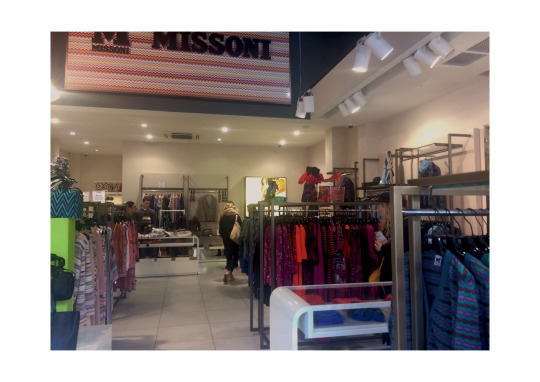
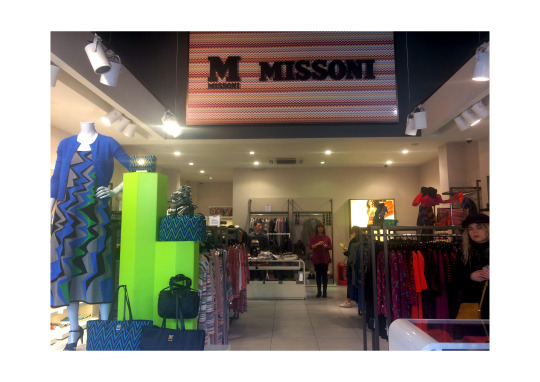
Colour Combination
On initial arrival I was looking out for the colour combination of the mood board I had created earlier in the week. For me I was looking for two main things; One that the colour was apparent and around, to know it is desired and aesthetical but also to understand that it was not being used everywhere and anywhere. It is important that it is not covering the vicinity of most store spaces as with Graduate Fashion Week being a few months away it may be then a trend that has come and gone and therefore making the stand look dated and not fresh and exciting.
It was apparent that the colour combination is definitely used separately with cobalt blues and tangerine shades of oranges present in most stores. I was glad to see the combination of the two had only been used in a few stores and only mostly on items of clothing or accessories. This therefore leaves somewhat a ‘niche’ for the stand to be that colour combination, without it being brash. I am pleased that it wasn’t used as a colour combination for décor or interior design however this means that discovery, sampling and development is required to ensure the combination works well if we choose to run with it.
I noted that currently red, yellow and blues are in. Following the palette of artist Piet Mondrian, it creates an arty, poppy and bold presence. To me a little over powering but it is interesting to see bold colours being used across stores as this indicates the bold colour combinations of blue orange and pink could then work well without being over powering.
Below are images collated displaying both the desired colour combination being shown and other displays of colour I liked.
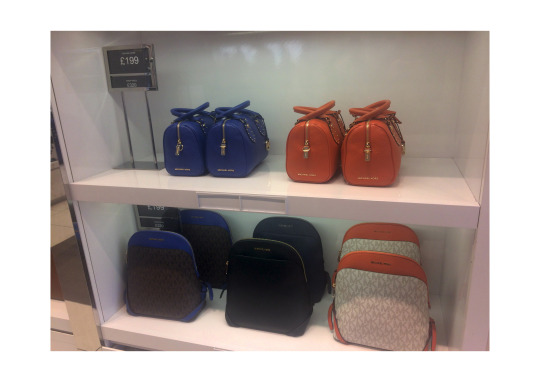
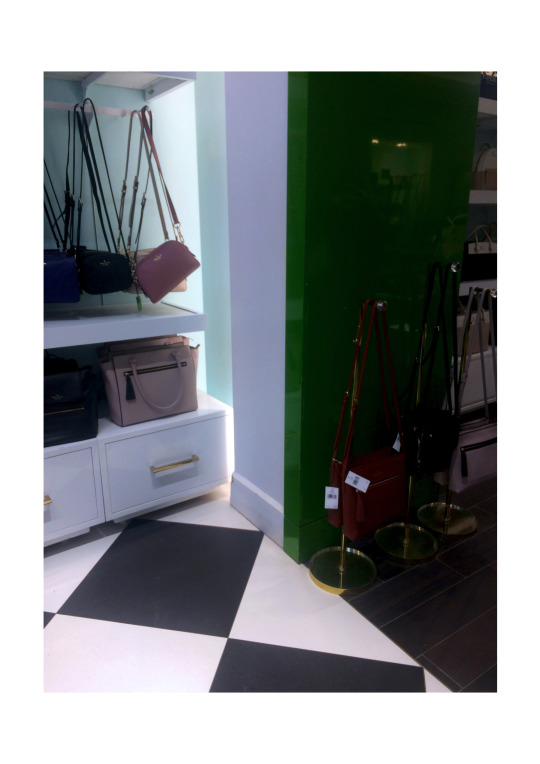
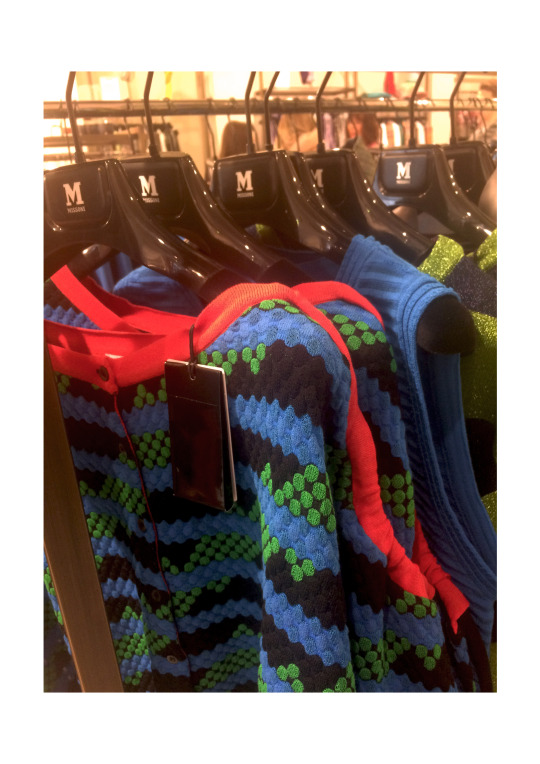
Displays
Looking at how these high-end retailers display items of clothing, accessories and items was a crucial part of research from today. At Graduate Fashion Week there are several displays that are necessary to showcase students work, with a complete range of items to be displayed. Although we are fairly in the dark about what is currently being displayed it provided good inspiration for what style of displays are currently being used, what looks good and perhaps common themes that are used. Below are images taken from displays that I thought looked and worked effectively to display items, I will break each one down explaining why I chose them as inspiration.
I chose this display as inspiration as if you look closely it has the same wooden chipping style of material as the tables we are required to use as Graduate Fashion Week. Our tables are currently untouched whereas this display has used white paint and a laminate over the top. It provides a completely different style and aesthetic to the wooden shade of table we are using and perhaps could be a consideration for alteration after experimentation and development. I think it has an interesting textured look that almost mimics marble. It could work better with certain colour combinations. I like the shape of this display and how it only displays one item, it makes it look minimalistic and well considered. It could be an option for displaying items such as accessories, publications, iPad’s etc.

The display here that caught my attention due to the hanging rails of the clothing. It gave a sophisticated edge that seemed to be well ordered and organised. It looked really sleek and although a lot of items of clothing are being displayed on it, it doesn’t look overbearing. This and other displays I saw throughout the day have made me consider the possibilities of scrapping mannequins and perhaps displaying clothing purely on rails as it seems that not many retailers here used mannequins and I think the rails look more organised and aesthetically refined.
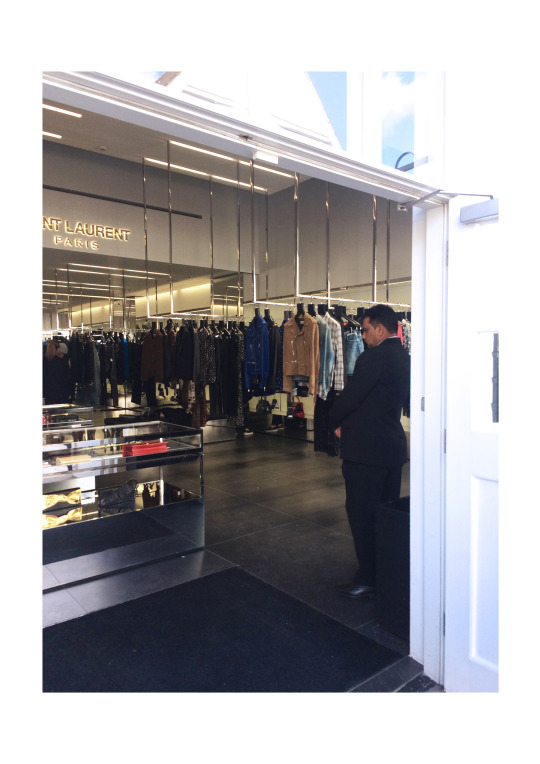
The industrial style of shelving was used quite a lot throughout the retail village and I know myself it is a very popular style. I really like the look of it and think it gives a shabby chic appearance to the stand. It is defiantly a style to consider further down the line. However, it was the style used on last years display heavily so it is important to move away from what was created last year. I was really drawn to the minimalism of this display stand. I liked that it accommodated for both clothing and accessories. It is easy to see the items from afar but also entices you to explore them up close. I like the combination of wood and metal I think aesthetically it is very strong.
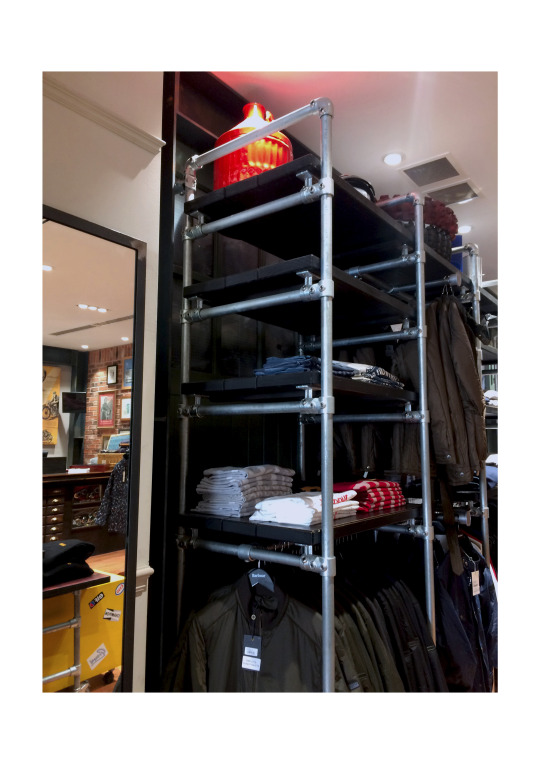
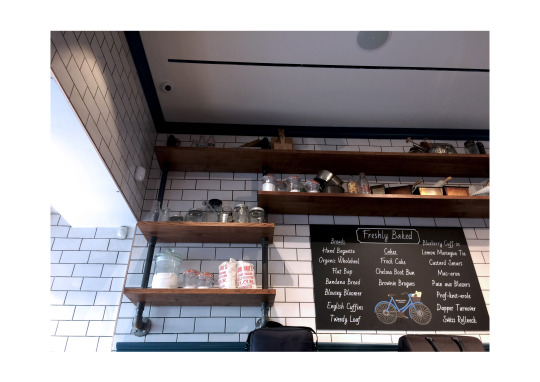
This is clearly a very eye-catching way of displaying the item shown. It is suits quite a geometric style of aesthetic. I am unsure of the practicalities of using it at Graduate Fashion Week due to expenses, but it shows a more experimental style of display.

Use of graphics was another feature that was prominent in a lot of stores. I think it works well and creates a more artistic display and it is definitely very doable for Graduate Fashion Week, so it is definitely something to consider.
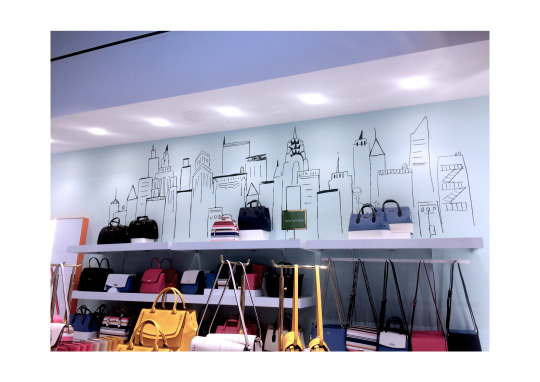
The colour combination of bold bright colours on this cube display work well. I think it is a strong way of displaying smaller items like accessories or communication work like publications. It could look good with the use of our possible bright colours of orange, blue and pink.
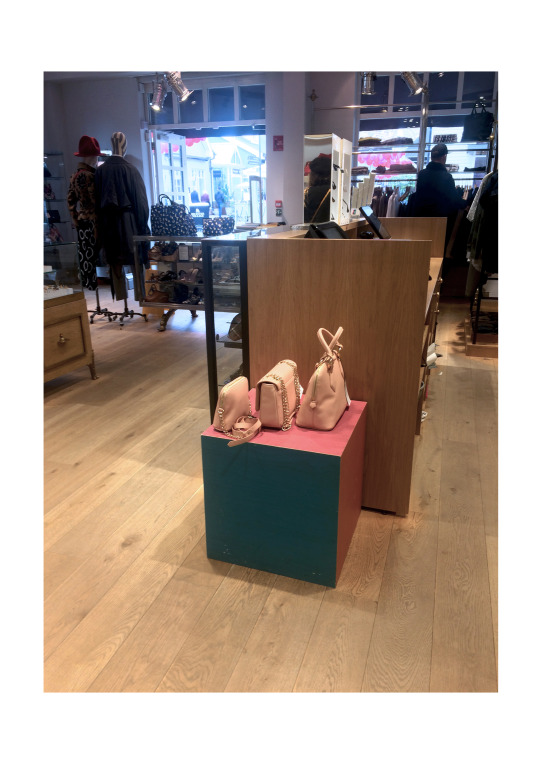
Again, another well organised way of displaying both clothing and accessories. It looks neat and uncluttered for the amount of clothing it is showing. It also displays a slight co-ordination of colours which also works well.
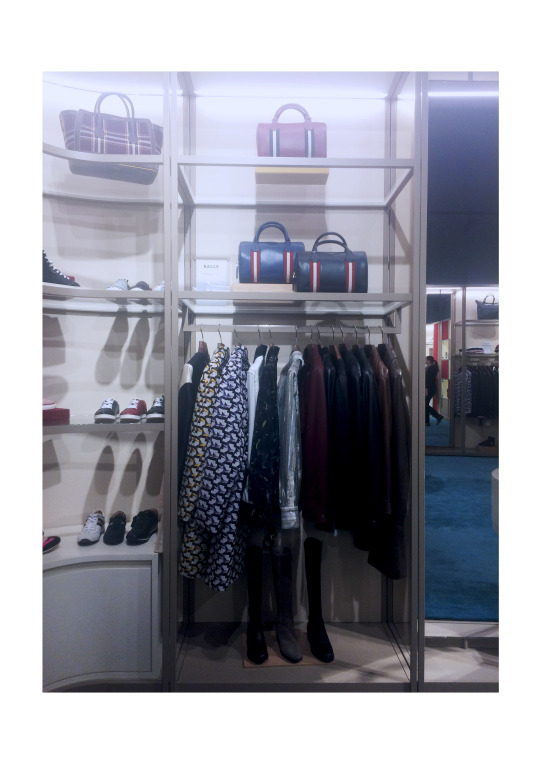
This displays a really innovative way of displaying items such as small clutch bags. It is instantly eye catching and draws the customer into the product. At Graduate Fashion Week it is crucial to capture the attention of onlookers encouraging them to explore the work of students further.
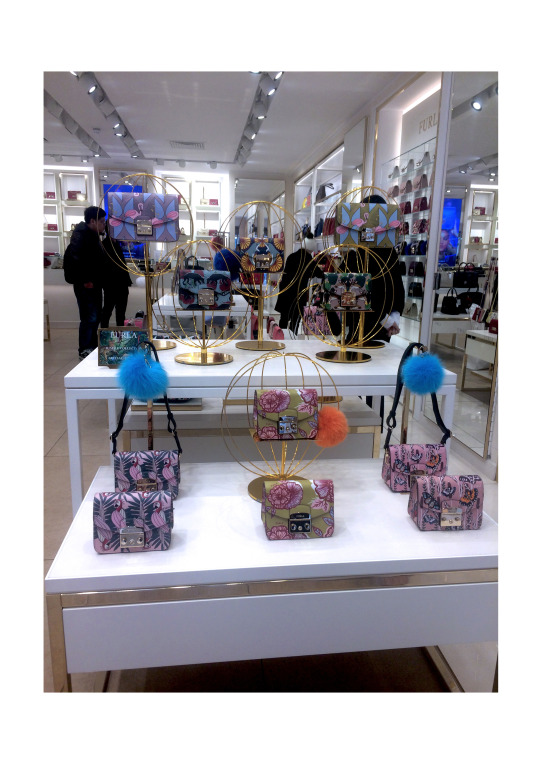
Finer details like customisation of the coat hangers works really well to put a stamp on the stand. It may be a consideration using the laser cutter to engrave AUB on hangers just to show further considered aesthetic to people viewing the clothing and make it clear at all times it is AUB’s work making it memorable.
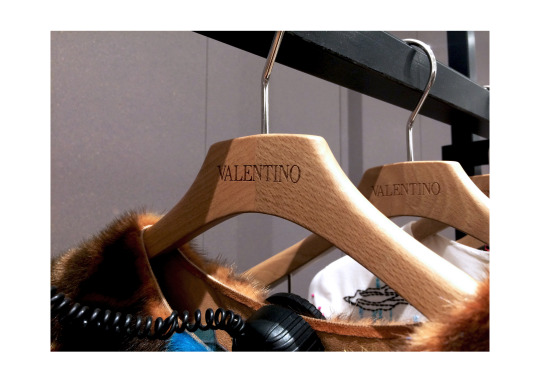
Photo Frames
Framing of pictures and photos around stores seemed to be a common feature used. I like the effect it has and think it works well and draws the customers eyes in. It looks considered and styled rather than just having large images of shoots on the wall which is common lower down in retail. I think it could be a really interesting way of displaying photography from communication students work or the NIL magazine shoots. Variation in sizes of frame and shapes create quite an interesting style.
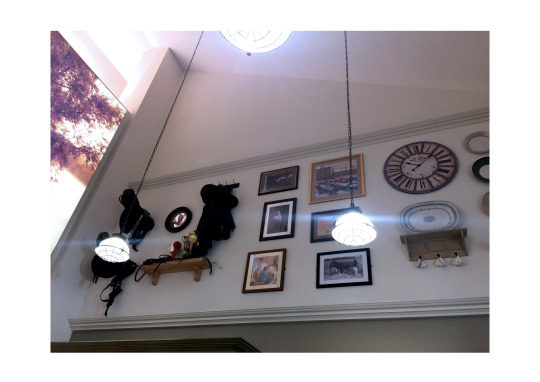
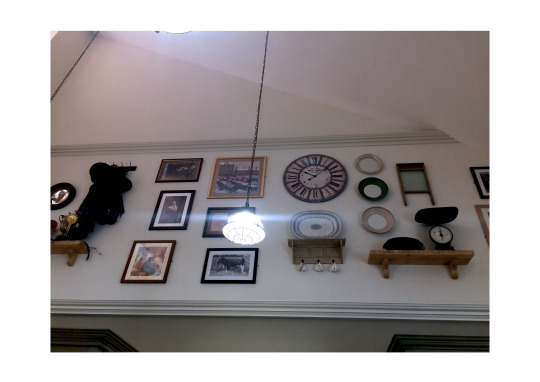
Lighting Spotlighting was used frequently in stores, to highlight items and also set a more mellow experience within the store. I think it is a feature that needs to be heavily considered within the stand at GFW.

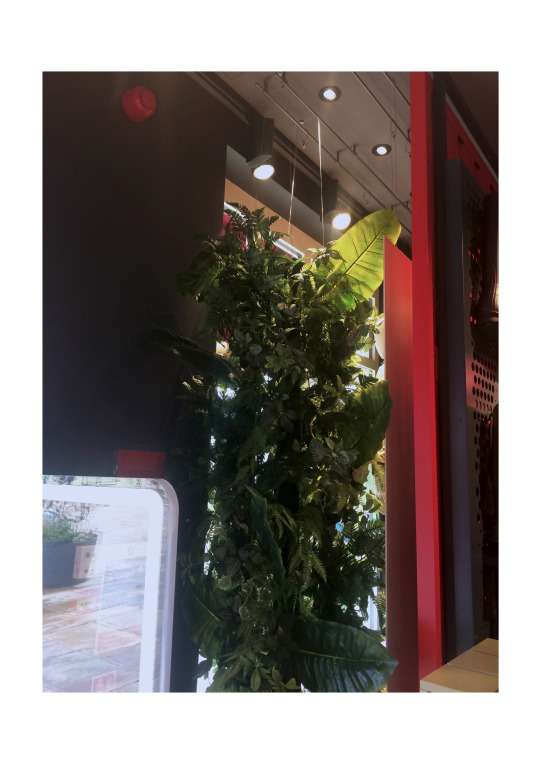
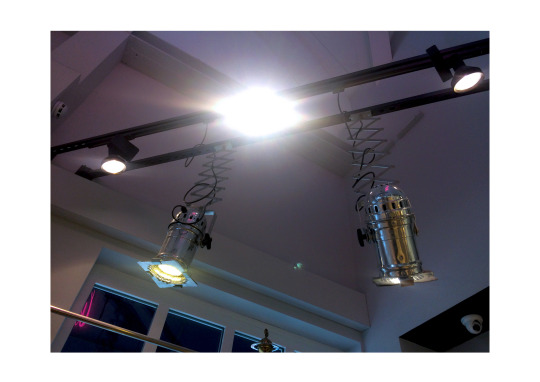
Neon Lights
Neon Lights bent into words were used vastly across the village. It creates a retro vibe and does really grab your attention to the words. It combines light and colour that will instantly attract consumers. I think if it is feasible it could definitely be an element that should be incorporated at GFW as the effects are strong, it is clearly also popular amongst high end retailers.
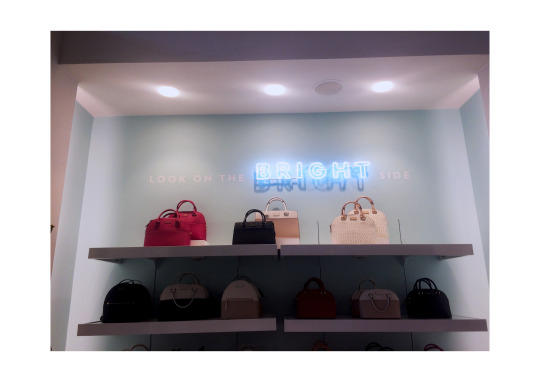

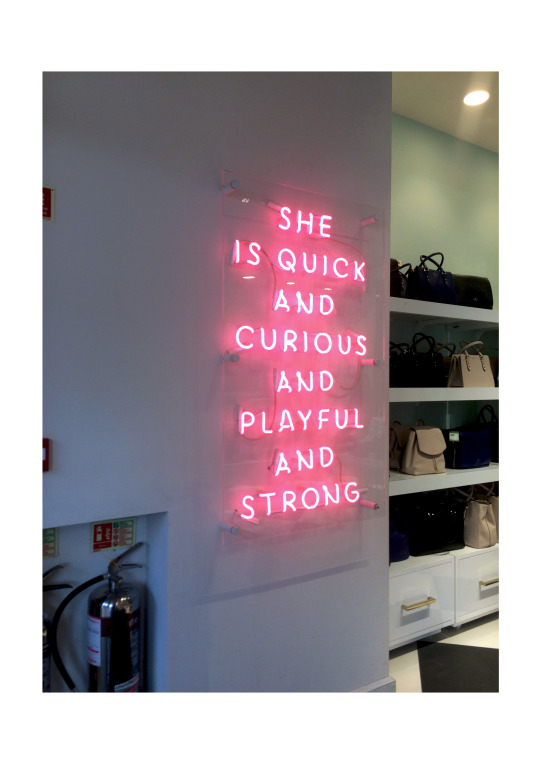
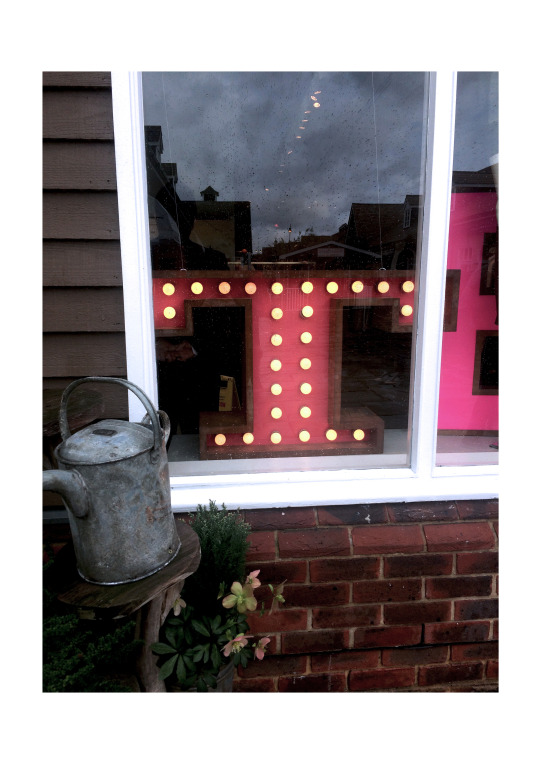
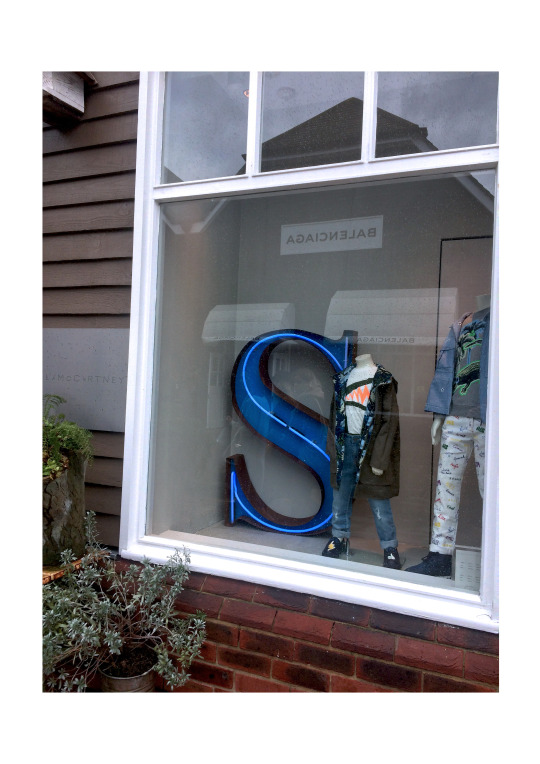
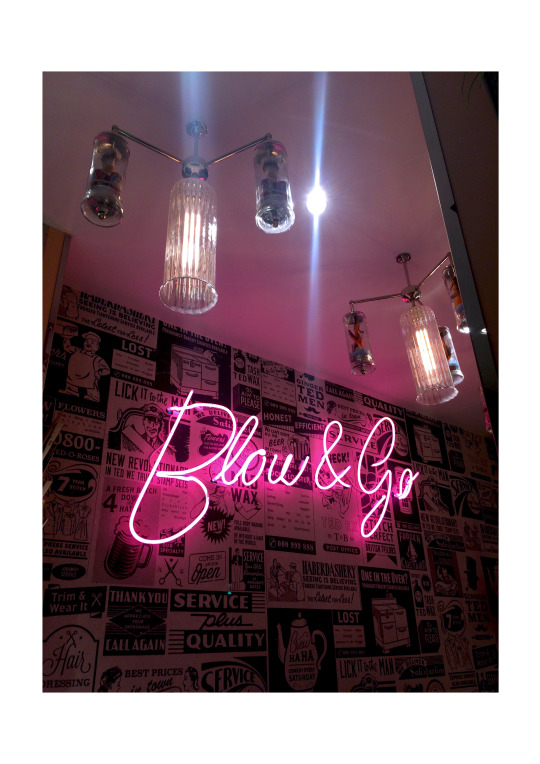
Mirrors
Mirrors of varied shapes and sizes were used across most stores. Although they do have a more practical use such as showing customers what they look like wearing items they also add decorative value to stores. Mirrors are also used to falsify the feeling of added space to stores, and as the space available at GFW is fairly small this technique could be work really well. Mirrors can work to create space by “expanding walls, amplifying light, breaking up visual clutter, mirrors can be used to solve most any design dilemma” (Moss L. 2012).
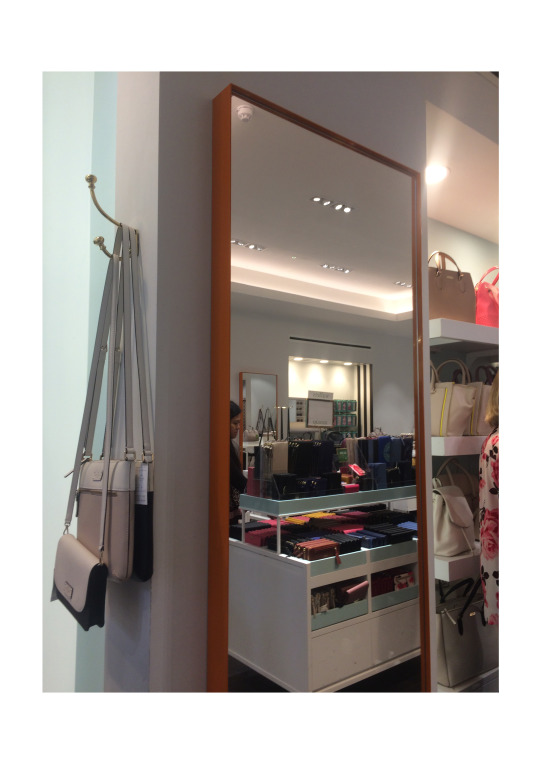
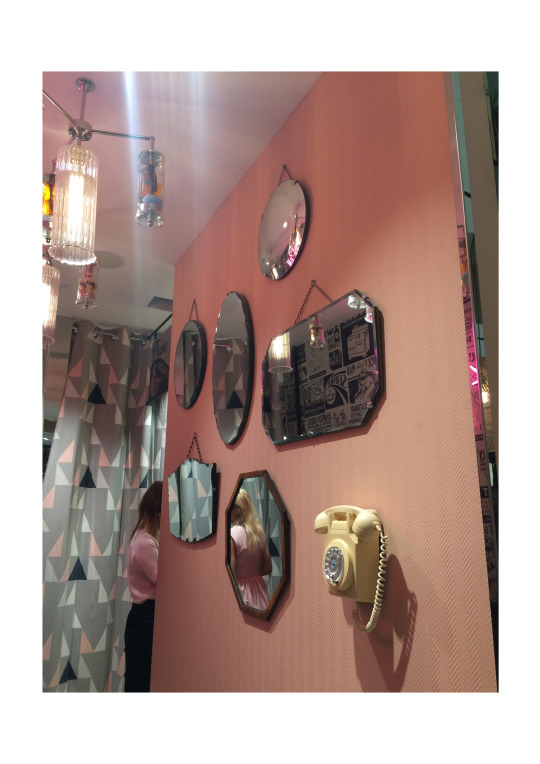
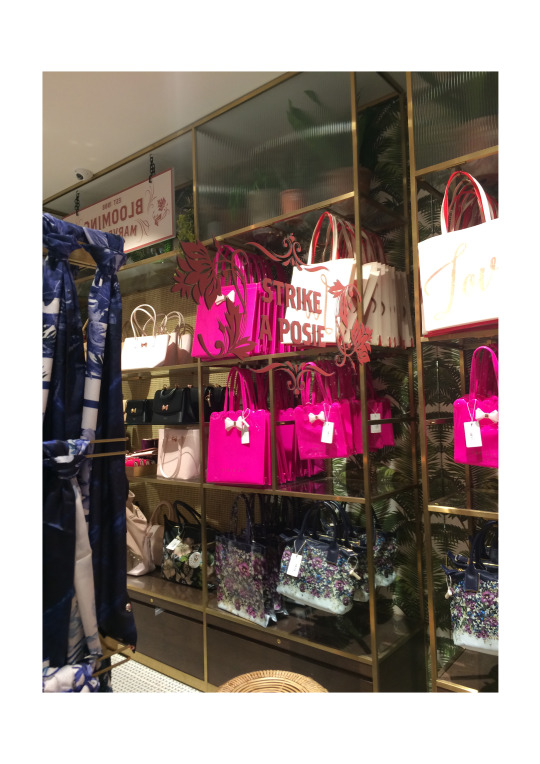
Technology
As most the stores were that of luxury high end retailers obviously their budget for store layout and design is great. Therefore, a lot of them incorporate technology as visual communication strategies throughout their stores. It is a really good technique to enticing consumers to look at a display, imagery or information wishing to be read. Although the displays here were vast and probably expensive research into cheaper alternatives could work well at Graduate Fashion Week.
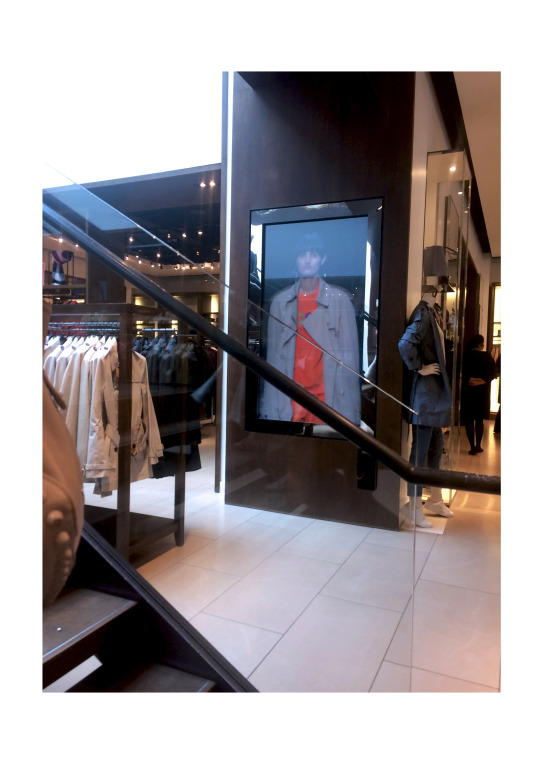
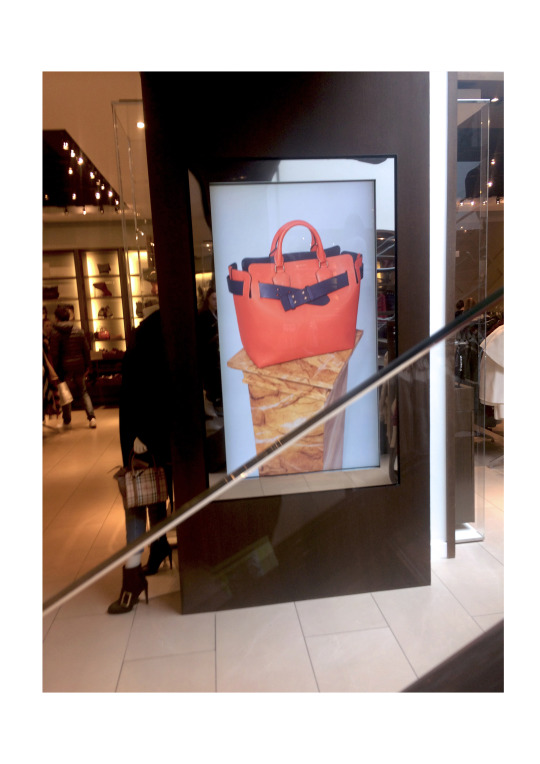
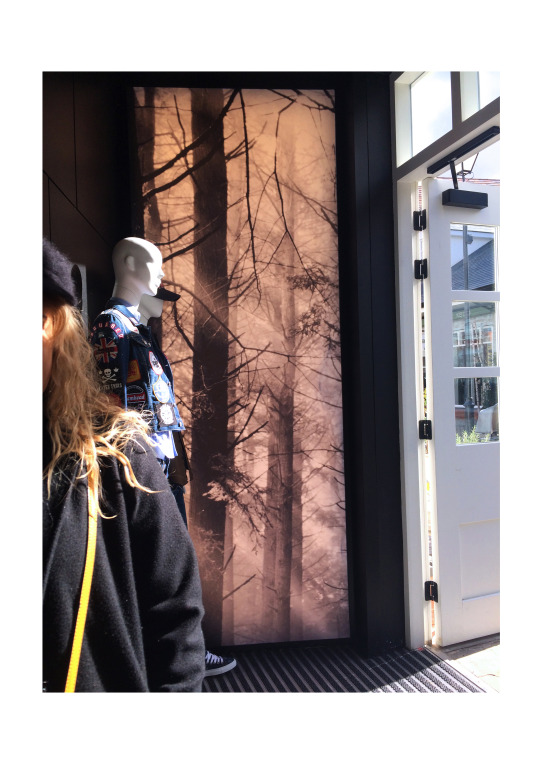
References Beks P. [2009] The psychology of colour at retail [online] Available from: https://www.retailcustomerexperience.com/articles/the-psychology-of-color-at-retail/ [Accessed 10th March 2018]. Moss L. [2012] Tricks of the Trade: 5 Smart Ways To Use Mirrors In Small Spaces [online] Available from: https://www.apartmenttherapy.com/5-perfect-ways-to-use-mirrors-in-small-spaces-168900 [Accessed 10th March 2018].
0 notes
Text
Learning Agreement TWO
Live Brief - Plastic Ocean (Helen storey & FFF)
In October of 2017, I signed onto an extra curricular activity called “Life on the Outskirts” Run by the Helen Storey Foundation. This is a project that will allow me to use Textiles to highlight an important issues within social, political or environmental factors. Along with this, I have also decided becoming involved with working within the T.I.P short course “Fashion, Form and Fabrication”. “FFF” is a 3D / mixed media crash course which allows us to explore the structure of the collar and how we are able to use the neck area of the body as a tool to present out textile works. We will be focusing on fashion technology, analysing the structure and pattern creation that is involved in constructing a traditional collar piece and using this information to inform what we will work towards as a final piece. 3D printing is an essential part of this, and I am very intrigued by incorporating this technique within my work as their is such a huge focus within the importance of the use of this technique within the future of the textile industry. Because the Helen Storey project is only mentor based, where no set work is given for us to complete, I have decided to create a Hybrid live project between “Life on the Outskirts” with “FFF”.
Within this project, I am to explore the issue of plastic waste being released into the ocean and how it has severely effected marine life and could have disastrous consequences for the future. It is a topic that I discovered that I was increasingly passionate about, to the extent that I even developed an anger, a desire to make a difference. By becoming part of the Helen Storey program, I was able to realise how I may be able to use my own artistic practice to create powerful change within the world and the environment. In essence, I will be able to use Textiles as a canvas to present pressing issues within the present day, something that I have never done before in my practice. I want to challenge my usual practice and do something completely out of my comfort zone. In my last project, It seemed that I may perhaps of worked in a predetermined way and that I needed to allow my work to develop in a much more organic way, rather then working towards a rigid end goal. I believe that by combining my passion that i found by working with Helen storey and combining this with the new skills and technologies that I will be learning in FFF that I will be able to develop a strong body of work that both challenges my usual approach to textile design and allows to to develop a more free yet efficient style in the way that I develop my own work.
I have produced a vast collection of visual imagery from Television documentaries as I have been an avid watcher of the new Blue planet 2 series, along with the addition of watching the Sky documentary “Plastic whale”. Both of these have been invaluable resources that have enabled me to wake up to the huge scale of the problem that plastic waste presents. On my visit to Première Vision - Paris, I discovered several textile manufacturing companies which collected plastic from the sea which used these materials to develop recycled yarns. This enabled me to produce additional research in how companies have been able to incorporate recycled plastics with there product creation, such as the Adidas 3D printed shoe made from ocean plastic waste in 2015. I also produced a vast amount of online research into companies, artists and designers who have explored the issues attached to waste being released into the ocean and its impact on the planet. Additionally, I have also produced research that looks at how structures, patterns, surfaces and textures can be created by reproducing ocean aesthetics. I have also been fascinated by the creation and use of bio plastic and how this can be used to tackle the huge problem we have of plastics damaging the environment.
I am to incorporate this research within my work by collecting waste plastics that I either use or find within my work to create abstract collages or drawings, experimenting with composition and scale to use this plastic in a function manner that stops it from entering the environment. I also aim to use these materials to experiment with creating mixed media textures. Although I aim to produce a series of developed drawings, I feel that this project needs to remain more mixed media based, as i feel that it is a more appropriate medium/ style to work with. I am to also use the structure of these materials in the development of my FFF work. Working within 3D printing and perhaps Laser cutting, I want to ensure that I am either using found materials or using materials that have been previously recycled or saved from the rubbish bin. As a result, I plan on making serious inquiries into how I may be able to create an outcome for my FFF work while using sustainable materials. As this is also linked toward the Helen storey project, I feel as if that this object that I create needs to be something that is much more exhibition / concept based, as the end product will be exhibited in autumn of this year in a exhibition. As the Helen storey project carries on after the hand-in for this unit, I will continue to develop work which can be used additionally with the artwork that I create for this aspect of the project. Perhaps in my own time I can continue to develop the cyanotype printing technique I explored in my last project along with printing techniques with a mixed media approach, perhaps creating a print collection or fashion outcome.
0 notes
Text
Getting Intimate With The V
There’s been an upsurge of attention focusing on products specifically geared toward the vagina (yes, we said it!) and its surrounding area…and it’s about time! After all, what you use to cleanse and moisturize your armpits with isn’t necessarily safe – or right – for your lady parts. While talking about vaginas used to be taboo, with companies like The Perfect V making and marketing products specifically for the vagina and surrounding area, we’re finally able to have the dialogue we’ve been shushed from having for too long. And, perhaps even more importantly, giving our lady parts the luxury and TLC they deserve, just as we do with our face and décolletage.
We spoke exclusively with Avonda Urben, founder of The Perfect V, about all things V…
Beauty Banter: What is the V?
Avonda Urben: We needed a name for the area “down there” – why not the V? Simple, straightforward, and the shape of that area makes it a no-brainer. I wanted something that we could say without giggling, being embarrassed, and without a lot of hand gestures showing what we are talking about. We have an arm, a leg, a knee, now a V. The V is the bikini line and where hair grows (where the hair grows – mons pubis) and the delicate area surrounding it.
BB: What is the genesis of The Perfect V brand? AU: Living in Copenhagen the last six years has given me a chance to be a little less uptight – more free in the way I think about my body. At a young age, all the girls shower together in one big room before you go into the pool, and at first I was looking for the individual stall for me and my 8-year-old daughter to change in. But then I realized there were NO individual dressing rooms – everything is out in the public. At first it was a little intimidating and embarrassing, but now it’s so easy.
So that is how my mind was even open to thinking about this idea. I was working on a BB Cream for a client (I was a marketing consultant), and I went through the alphabet: CC, DD, EE, GG, WW creams, and I realized there wasn’t one for VV…I thought that would be so great for the V area…. a multi-tasking skincare product for the V – VV Cream…..for the V. I trademarked it so no one else can have a V Cream. I researched the global marketplace – there are so many products and lines and companies that talk to us (women) using such an old-fashioned approach. The categories are feminine care, intimate, hair removal, and men’s grooming. I didn’t want products called feminine care (old fashioned pink and white packaging), intimate (sexual in nature), hair removal (just not beauty; they throw an aloe strip on the razor and there you go – beauty!), and then, my personal favorite – men’s grooming – who wants a product that men use for their beards? I wanted something that made me feel good; that I was pampering myself like we do for the rest of our body and face. And I didn’t want to have a product that stated red bumps or ingrown hair on the packaging in big letters. Why not an elegant product? Something that could sit with all our other beauty items and not shout a problem? Our products address problems/solutions, however they are all about the beauty for the V – luxury skincare.
BB: Why should all women have products strictly for their V area? AU: You don’t really need products for the V – doctors say soap and water are fine. I think doctors say that about the face and body too…but we have special products for those areas. I think the need or want for products strictly for the V area is driven by the global behavior of removing hair in the V area. Women are shaving, waxing, sugaring, lasering, using depilatories so there is more skin that is exposed and skin that needs to be taken care of. I notice more of the area and want it to look good, and, even more importantly, feel good. Just want to note that if you have hair there, it is still good to use these products because it is like our hair and our scalp – we want to condition and take care of our scalp too.
Please note: This line is for the external use of the skin (it is not the vagina). The wash, the mist, and the beauty sheets are used on the outside and are safe to go in but not designed to go into the vagina. These products are designed specifically for the V.
BB: Can you give us a quick how-to on highlighting the V? AU: It’s easy: After you have been taking care of your V, pampering it with The Perfect V Regimen, your V will look even better than it already does. Just add a small drop of Shades of V Luminizer on the exposed area and you will see a beautiful iridescent luminosity. It’s subtle but noticeable, looks great with lingerie and when you have a bathing suit on. A lot of women are now using it for their legs, décolletage, and arms; it’s that pretty and feels great! Note: putting it on with a brush is awesome too -the makeup artists did this for our Miami Runway show and it looked so flawless.
BB: What’s the one must-have product for the V? AU: Oh, now that’s a tough one because you don’t need all eight products….at the same time. There are different products for different reasons. But if I had to choose one…I guess it would be the VV Cream because it is so luxe and feels like I am really taking care of every part of my body.
If I was going on a date, I would definitely take two products: the VV Beauty Sheets and the VV Mist; super fresh so I would feel super confident.
*images courtesy of The Perfect V
The post Getting Intimate With The V appeared first on Beauty Banter.
Getting Intimate With The V published first on http://ift.tt/2ulU08O
0 notes